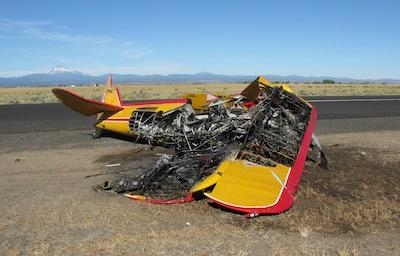Fri, Aug 17, 2018
Cites Pilot Error During Low-Level Maneuver
The NTSB has released its probable cause report from an accident which occurred August 27, 2016 that fatally injured airshow performer Marcus Paine during the Cascades Airshow in Madras in Oregon.

According to the report, Paine was attempting to perform an inside loop immediately after takeoff in his Stearman as part of his performance. He had successfully accomplished the maneuver the previous day, as well as at many previous air shows. Witnesses observed the airplane lift off the runway and remain in a level attitude just above the runway surface before it climbed to perform the loop.
Witnesses reported that the airplane descended from the top of the loop to a point in which its pitch attitude was between 10° and 20° nose-down until it impacted the runway. Video footage of the accident indicated that the pilot was in control of the airplane throughout the maneuver, and postaccident examination revealed no evidence of a preimpact mechanical malfunction or failure that would have precluded normal operation.
Another performer at the airshow reported that, during the evening practice the day before the accident, he observed the pilot perform the same maneuver, and described it as "sketchy" because of the low altitude at which the pilot completed the loop. He added that he previously asked the pilot how to perform this maneuver and the pilot said that it was a "complete crapshoot"; at the top of the loop, the pilot would decide whether he would "pull through and continue the loop or rollout into a half-Cuban or an Immelmann," both of which are recovery aerobatic maneuvers.
Prior to takeoff, the Air Boss reported to the pilot a density altitude (DA) of 4,600 ft. Postaccident calculations revealed that the DA at the time of the accident was about 5,221 ft, both of which are well above a standard day. The high density altitude conditions would have degraded the airplane's overall performance, resulting in decreased engine power available and reduced rate of climb. It is likely that the pilot failed to adequately compensate for the changes in airplane performance due to the high density altitude conditions, which resulted in a collision with terrain.
The NTSB determined the probable cause(s) of this accident to be the pilot's failure to maintain clearance from the runway during a low-level aerobatic maneuver. Contributing to the accident was a high density altitude and the pilot's failure to plan/adequately compensate for high density altitude conditions.
(Image from NTSB accident docket)
More News
Touchdown Zone Lighting Two rows of transverse light bars located symmetrically about the runway centerline normally at 100 foot intervals. The basic system extends 3,000 feet alon>[...]
“Discovery and innovation are central to our mission at Virgin Galactic. We’re excited to build on our successful record of facilitating scientific experiments in subor>[...]
"We are reaching out to you today on behalf of the Popular Rotorcraft Association because we need your help. We are dangerously close to losing a critical resource that if lost, wi>[...]
UAS Traffic Management (UTM) The unmanned aircraft traffic management ecosystem that will allow multiple low altitude BVLOS operations and which is separate from, but complementary>[...]
Aero Linx: Society of Aviation and Flight Educators (SAFE) SAFE is a member-oriented organization of aviation educators fostering professionalism and excellence in aviation through>[...]
 ANN's Daily Aero-Term (05.02.24): Touchdown Zone Lighting
ANN's Daily Aero-Term (05.02.24): Touchdown Zone Lighting Aero-News: Quote of the Day (05.02.24)
Aero-News: Quote of the Day (05.02.24) Aero-News: Quote of the Day (05.03.24)
Aero-News: Quote of the Day (05.03.24) ANN's Daily Aero-Term (05.03.24): UAS Traffic Management (UTM)
ANN's Daily Aero-Term (05.03.24): UAS Traffic Management (UTM) ANN's Daily Aero-Linx (05.03.24)
ANN's Daily Aero-Linx (05.03.24)



